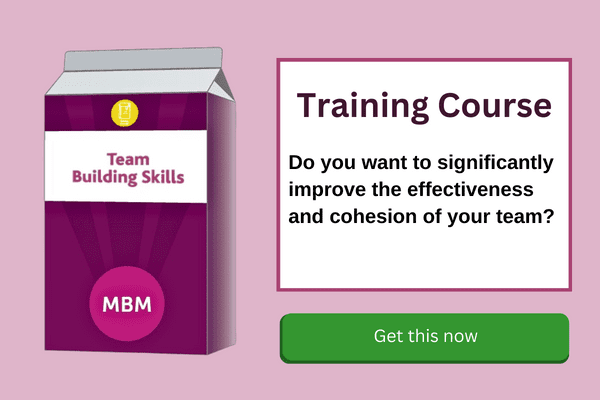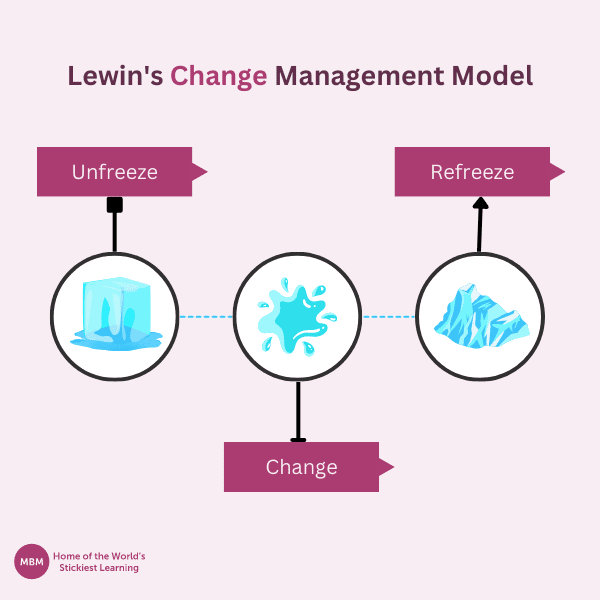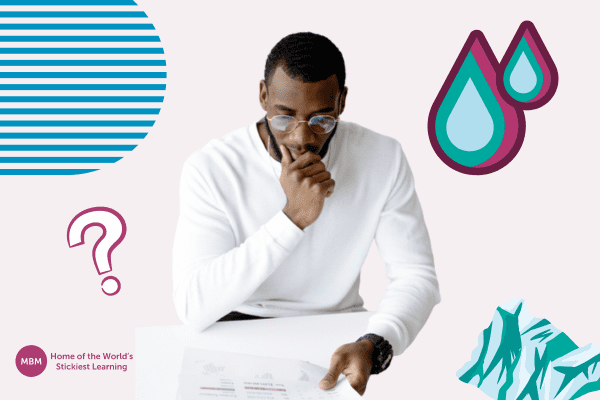How Lewin’s Change Management Model Can Help Your Organisation Thrive
Explore the magic of Lewin’s Change Management Model, also known as the Unfreeze-Change-Refreeze Model or Evolutionary Transition Framework, a powerful tool for understanding and managing organisational changes. Crafted by Kurt Lewin, a pioneer in social psychology, this model has found widespread use in business and various fields to aid organisations during periods of transformation and advancement.
The model is constructed upon the notion that successful change transpires in three key stages: preparing for change, implementing the change, and solidifying the new state. It offers a clear and methodical approach to navigating shifts within an organisation.

How is Lewin’s Model Different?
What sets Lewin’s model apart from other change management frameworks is its focus on the human side of change.
Think of having a block of ice but wanting an ice cone instead. To make this change, you first melt the ice to be open to reshaping (unfreeze). Then you mould the water into a cone shape (change). Finally, you solidify the new form (refreeze), mirroring Lewin’s three stages.
The model stands out by focusing on the human side of change. Unlike some approaches that prioritise processes, this model recognizes that people drive change. Success depends on employees being willing and able to embrace new ways of working.
By unfreezing old habits, creating a clear vision for change, and anchoring new behaviours, It offers a valuable tool for leaders and change agents to anchor new behaviours and practices. It helps drive meaningful and lasting change in organizations, making it simpler for them to adapt to new circumstances.

What Are Lewin’s 3 Stages of Change?
Stage1: Unfreezing- Preparing for Change
The first step in the Evolutionary Transition Framework is unfreezing. This involves preparing the organisation for change by identifying the behaviours and beliefs that need to be changed.
During this stage, leaders must create a sense of urgency and build momentum for change. This can be done by describing the need for change, setting goals, and creating a plan of action.
The key is to get everyone on board and excited about the change.
Stage2: Changing- Making the Change Happen
The second step in the Model is changing. This is the stage where the actual change takes place.
During this stage, leaders must implement the plan of action that was created during the unfreezing stage. This can involve restructuring, reorganising, and retraining employees.
It’s important to communicate clearly during this stage and to provide support to employees who may be struggling with the change. This can include providing training and coaching and celebrating small wins along the way.
Stage3: Refreezing- Anchoring the Change
The refreezing stage of change is the final stage. It involves anchoring the new behaviours and practices that were established during the changing stage. This can involve implementing new policies, procedures, and structures that support the new way of doing things.
It’s also important to recognise and reward employees who have embraced the change and to communicate the benefits of the new way of working. By doing this, leaders can create a culture of change and innovation that will help the organisation continue to evolve and adapt over time.
Why Lewin’s Change Model is Important?

1- Benefits of Implementing the Change
Another benefit of using the Unfreeze – Change – Refreeze Model is that it emphasises the importance of implementing the change. During this stage, leaders must implement the plan of action that was created during the unfreezing stage. This can involve restructuring, reorganising, and retraining employees.
By doing this, leaders can ensure that everyone is on the same page and working towards the same goal. It’s also important to communicate clearly during this stage and to provide support to employees who may be struggling with the change. This can include providing training and coaching and celebrating small wins along the way.
2- Benefits of Anchoring the Change
An important benefit of using the Model is that it emphasises the importance of anchoring the change. During this stage, leaders must implement new policies, procedures, and structures that support the new way of doing things.
It’s also important to recognise and reward employees who have embraced the change and to communicate the benefits of the new way of working. By doing this, leaders can create a culture of change and innovation that will help the organisation evolve and adapt over time.
3- Overall Benefits of Lewin’s Three-step Change Management Model
The overall benefits of using the Evolutionary Transition Framework are numerous. This framework offers a clear and systematic approach to managing change that can help leaders navigate periods of transformation and growth.
By following this model, leaders can ensure that the change is successful and that the organisation can continue to evolve and adapt over time. This model also emphasises the importance of preparing for change, implementing the change, and anchoring the change, which can help to create a culture of change and innovation.
By using this model, leaders can help their teams embrace change and move forward with confidence.
Evolutionary Transition Framework Real-life Experiences

The Evolutionary Transition Framework is a proven framework that can be applied to many different scenarios, from business mergers to cultural changes. In this section, we will explore how the model has been successfully applied in various industries and organisations.
Example 1: Implementing a New Technology
When a major technology company decided to introduce a new software platform, it used the Evolutionary Transition Framework to guide the change process.
First, they unfroze the existing systems and processes by communicating the need for change and building support among stakeholders. Next, they implemented the new technology in stages, providing training and support for employees along the way. Finally, they anchored the change by introducing new policies and procedures that supported the new technology.
As a result of using this model, the company was able to successfully implement the new technology and improve its overall efficiency.
Example 2: Merging Two Companies
When two financial institutions merged, they used the unfreeze – change – refreeze model to guide the change process.
First, they unfroze the existing cultures and systems by communicating the need for change and building support among stakeholders. Next, they implemented the changes in stages, focusing on creating a unified culture and standardising processes. Finally, they anchored the change by creating new policies and procedures that supported the new company culture.
As a result of using this model, the merged company was able to successfully integrate the two organisations and improve their overall performance.
Example 3: Implementing a New Marketing Strategy
When a retail company decided to overhaul their marketing approach, it used the same model to guide the change process.
First, they unfroze the existing marketing strategy by communicating the need for change and building support among stakeholders. Next, they implemented the new strategy in stages, gradually shifting resources and focusing on the areas of greatest impact. Finally, they anchored the change by creating new policies and procedures that supported the new marketing approach.
As a result of using this model, the company was able to successfully implement the new marketing strategy and increase its overall sales.
Example 4: Changing Organisational Culture
When a non-profit organisation wanted to shift their culture towards greater inclusivity and collaboration, it used Lewin’s model to guide the change process.
First, they unfroze the existing culture by communicating the need for change and building support among stakeholders. Next, they implemented changes in stages, starting with small pilot programs and gradually scaling up. Finally, they anchored the change by creating new policies and procedures that supported the new culture.
As a result of using this model, the organisation was able to successfully shift its culture towards greater inclusivity and collaboration, which helped them to better achieve its mission.
Strengths and Weaknesses of Lewin’s Model

Strengths of Lewin’s Change Management Model
One of the biggest strengths of this Management Model is its simplicity. This simplicity makes the model accessible to leaders at all levels, from small business owners to CEOs of large corporations.
Additionally, the model encourages leaders to implement changes in stages, which can help to manage risk and reduce the likelihood of unintended consequences.
Weaknesses of Lewin’s Change Management Model
While it has many strengths, it also has some weaknesses.
ne big problem with the model is that it doesn’t understand how complicated changes in organisations can be. In real life, making changes isn’t usually a simple step-by-step thing. It’s often messy and hard to predict. The model’s three-step plan might be too simple to cover all the things that can affect whether a change works or not.
Another weakness is that it can be slow to produce results. Because the model emphasises the importance of involving stakeholders and implementing changes in stages, the process can take longer than other change management models. This can be frustrating for leaders who need to see results quickly.
Tips to Implement Lewin’s Change Management in Your Organisation

1. Communicate Effectively
One of the most important factors in successfully implementing this Model is effective communication. It is essential to communicate clearly and frequently with stakeholders throughout the change process.
Leaders should communicate the need for change, the reasons for the change, and the benefits that the change will bring. Additionally, it is important to address any concerns or questions that stakeholders may have and to involve them in the change process as much as possible.
2. Build a Strong Team
Another important factor in successful implementation is building a strong team. It is important to ensure that the team members are fully aware of their roles and responsibilities and that they have the resources they need to complete their tasks.
3. Implement Changes in Stages
Implementing changes in stages is another best practice for successful implementation.
Rather than attempting to implement all changes at once, it is often more effective to break them down into smaller, manageable steps. This can help to reduce risk, identify and address potential issues early on, and build momentum and support for the change.
4. Monitor Progress and Adjust as Needed
Finally, it is important to monitor progress and adjust as needed when implementing. This can help to ensure that the change stays on track and that any issues are identified and addressed quickly.
Leaders should establish clear metrics for measuring progress and should regularly review and assess these metrics. If progress is not meeting expectations, adjustments should be made to get the change initiative back on.
Alternatives to Lewin’s Change Model

#1- Kotter Change Model
One popular alternative to the unfreeze – change – refreeze Model is the Kotter Change Model. Developed by John Kotter, a professor at Harvard Business School, this model has based on the premise that change requires a structured and strategic approach.
The Kotter Change Model consists of eight stages, including creating a sense of urgency, building a coalition, creating a vision, communicating the vision, empowering others, creating short-term wins, consolidating gains, and anchoring new approaches in the organisation’s culture.
#2- Prosci ADKAR Model
Another alternative is the Prosci ADKAR Model. This model has based on the premise that change is a process that requires individuals to move through five stages: awareness, desire, knowledge, ability, and reinforcement.
This includes building awareness of the need for change, creating the desire for change, providing knowledge and skills, enabling individuals to implement the change, and reinforcing the change to ensure it sticks.
#3- McKinsey 7-S Model
This model focuses on seven key elements of an organisation: strategy, structure, systems, style, staff, skills, and shared values. The model emphasises the interdependence of these elements and the need for them to be aligned to achieve successful change.
#4- Bridges’ Transition Model
Another alternative is Bridges’ Transition Model. This model has based on the premise that change is a process of transition and that individuals must go through three stages to successfully transition to a new state: an ending, a neutral zone, and a new beginning.
The model emphasises the importance of acknowledging the ending of the old state and the need to let go of the old ways.
Conclusion
In conclusion, successfully implementing Lewin’s Change Management Model requires effective communication. It also requires a strong team and implementing changes in stages. By following these best practices, leaders can increase the likelihood of success when using Lewin’s Change Management Model. Leaders should carefully consider their specific organisational needs and goals when deciding whether to use Lewin’s Change Management Model or other change management frameworks.
Enjoyed this article? See our other popular articles on Medium.
Updated on: August 18, 2023




